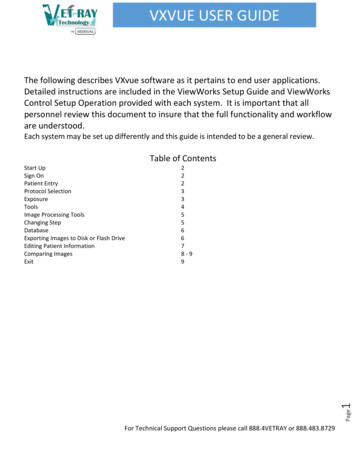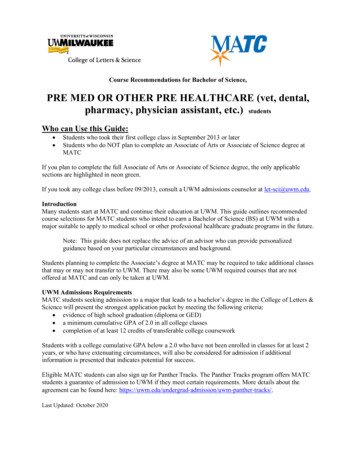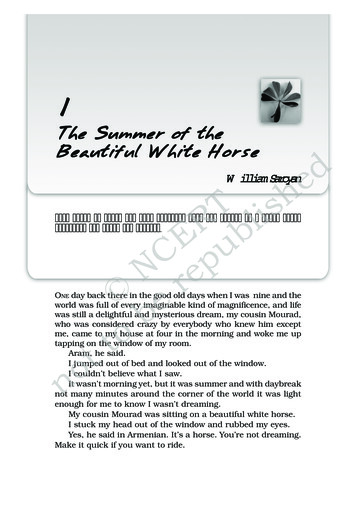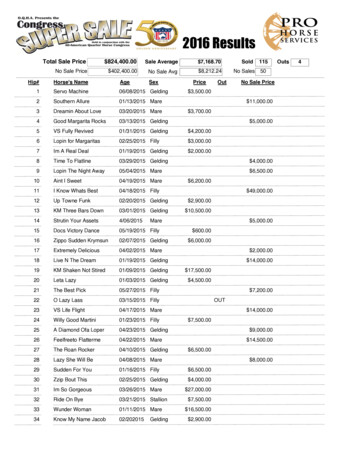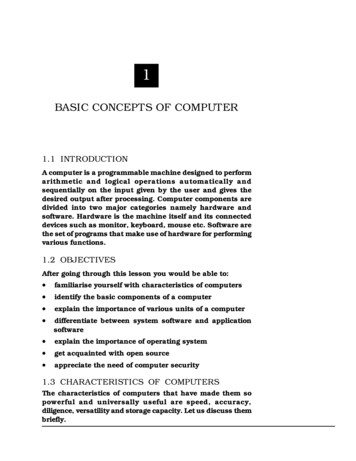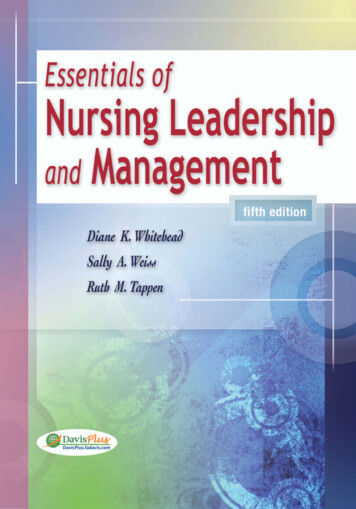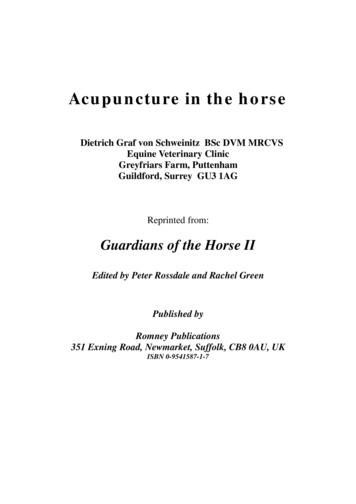
Transcription
Acupuncture in the horseDietrich Graf von Schweinitz BSc DVM MRCVSEquine Veterinary ClinicGreyfriars Farm, PuttenhamGuildford, Surrey GU3 1AGReprinted from:Guardians of the Horse IIEdited by Peter Rossdale and Rachel GreenPublished byRomney Publications351 Exning Road, Newmarket, Suffolk, CB8 0AU, UKISBN 0-9541587-1-7
50 ACUPUNCTURE IN THE HORSEDietrich Graf von SchweinitzAcupuncture in the horseDietrich Graf von Schweinitz BSc DVM MRCVSEquine Veterinary ClinicGreyfriars Farm, PuttenhamGuildford, Surrey GU3 1AGIntroductionMy first exposure to acupuncturein the horse came in 1981 while still astudent at the University of Georgia'sveterinary school. Here, I observedJanet Steiss (now a professor at theTuskegee University) conducting anacupuncture clinical trial on horseswith chronic lameness from eitherlaminitis or navicular disease. Thiswas published and the results, on theone hand, could be regarded asencouraging, while on the other, werestatistically insignificant (18). Janethighlighted the difficulties in conducting controlled clinical trials in equineacupuncture by reviewing her work atthe 1999 Congress of the InternationalVeterinary Acupuncture Society (IVAS)in Lexington, Kentucky.Two years later, in my first job as aveterinary surgeon, came my first personalexperience with the related therapy Shiatsu(acupressure), which came about as theresult of a severe kick injury to my hip froma horse. The spinal shock rendered meunconscious for a short while and I was takenby ambulance to the local hospital where Ihad an examination, including x-rays. I wasdischarged with a pair of crutches free of anyfracture with a firm swelling the size of agrapefruit on the side of my right hip andunable to take any weight on my right leg dueto pain.Additionally, I was given a course of strongpain medication (Darvaset) plus antiinflammatory drugs and instructed to stayconfined to bed for 3 weeks with my legelevated with frequent ice compresses for thefirst few days.The inconveniences included the fact that Iwas due to start a locum position for a soloequine practice in five days and I dreaded thenotion of disappointing a practitioner lookingforward to his much-needed holiday.One of my equine clients at the time, MichaelFarley, held acupressure clinics at the localmedical centre and, fortunately, was able to fitme in two days after the injury. In spite ofmedication it was still very painful to beupright and excruciating to put the slightestweight on my right leg. Michael applied firmthumb pressure for about two minutes at eachof approximately 12 to 15 points many of whichwere located around and on the swelling and ashe predicted the local sensation was one ofexquisite piercing pain slowly fading to a vaguenumbness.After about 30 minutes and a few expletivesmy right hip felt numb and I was able to standon it and walk, albeit with quite a limp. On thenext day I returned limping but withoutcrutches and only half a "grapefruit" on my hip.He repeated the acupressure treatment,mobilised my limb and instructed me to go outand jog about three miles. In spite of myprotests I did as instructed and found theswelling completely resolved and I was able toambulate almost normally. I went away veryimpressed to locum as planned and Michaelwent on to become well known in the U.S. as ahuman and equine acupressure therapist andfor developing a range of equine orthoticsincluding the Farley Boot.A few months later I attended an introductory equine acupuncture workshop hosted bythe University of Pennsylvania's large animalveterinary teaching hospital at New BoltonCenter. This was a practical demonstration on
GUARDIANS OF THE HORSE IIEdited by Peter Rossdale and Rachel Greenthe anatomical location of some of themore important acupuncture points andtreatment techniques in diagnosing andtreating back pain.Professor Alan Klide and clinician,Martin Benson of the University, hadrecently conducted controlled trials ontreating chronic low back pain in performance horses with acupuncture 11. At thetime I had a perfect experimental "guineapig" at home; Patton, my thoroughbredhunter gelding in his late teens who hadacquired a chronically stiff and stilted lowback and pelvic action over the past fewyears. He also had collapsed heels and flatsoles and was frequently slightly lame dueto foot soreness. While this lamenesswould resolve when put on butazolidin,the low back and pelvic stiffness did notrespond.When I practised locating the appropriate acupuncture points for low back andpelvic pain on Patton I was amazed byhow much local muscular spasm andevidence of pain could be elicited bysimple digital pressure on very discretelocations. I excitedly punctured five verytender acupuncture points (Bladder 25and 26, and animal Bai Hui at thelumbosacral site) with ordinary hypodermic needles (21 guage x 1.5 inch) andinjected 2 ml of vitamin B 12 solution intoeach point(a technique popular in theUS, referred to as aquapuncture).Three days later, I was astounded to seehim turnout into the paddock after hisnight in the stall with a youthful andexuberant gallop and series of playfulbucks which I hadn't seen from him formany years. This rejuvenation extendedto being ridden where suddenly I couldfeel a looseness in his lower back and animpulsion coming from his hind limbs;he was obviously enjoying feeling so welland the ride was wonderful. This effectfaded out over the course of two to threeweeks, but it was reinstated each time Iretreated him.I became increasingly aware of twoquite separate categories of pain, oneresponsive and the other unresponsive tonon-steroidal anti-inflammatory drugs(NSAIDs), the latter responding to aphysical and natural medicine. I alsonoted a strong connection between theacupuncture-controlled pain andbehavioural adjustment.51Acupuncture originsThe origins of acupuncture lie in prehistorictimes and may have originated in culturesoutside China. Evidence for this recentlycame to light with the investigations of thelargely preserved frozen corpse of the "IceMan, Oetzi", who has been dated toapproximately 5500 years. Oetzi has clearlyidentifiable dark stained points on his skinindependently confirmed by severalacupuncturists as classically describedBladder channel points at sites along hisarthritic lumbar spine. He has other clearlymarked classical acupuncture points on hislegs and around his arthritic ankle 21. It is notcertain that the Southern Alpine man in thatera had access to Chinese medicine practicesassuming these had already been developedin China at that time.The earliest written records of acupunctureare usually credited as originating from theHan dynasty in China around 3000 years ago.The Chinese Nei Jing texts from about 300100 BC and the Nan Jing from the firstcentury are regarded as the most importantwritten documents from the historicalcontext.These works described their observationsand theories of anatomy, physiology,pathology and treatments that includedacupuncture and moxibustion (heat treatment by burning mugwort). They marked thegenesis of medicine as distinct from religion(demonology) in China and focused onsymptoms as somatic rather than supernatural 1. During this period the emphasis onenvironmental factors causing disease hadlargely replaced the more primitive notions ofdemons and spirits inflicting disease. Themain threats to health were seen as excessesof the environmental forces (Yi qi) of wind,cold, damp, and heat entering a bodydeficient in its defence forces (Wei qi). Thetheories incorporated their already longstanding universal principles of yin-yang(opposites) and the concept of five phases(correspondences with the elements of fire,earth, metal, water, and wood) which are stilltaught as integral parts of traditional Chinesemedicine (TCM). There was also recognitionof the importance of balance and interactionwith the environment.At that time the human body's internalanatomy was described as composed of 11organs: the five solid (yin) organs of theheart, liver, spleen, lungs, and kidney, and six
52ACUPUNCTURE IN THE HORSEDietrich Graf von SchweinitzFig 1: 14th Century Chinese equine acupuncture chart (reprinted with permission from Mosby).hollow (yang) organs of the gallbladder,stomach, small intestine, large intestine,bladder, and the "tripleburner" (made up ofthe pleural and peritoneal cavities). A 6thsolid organ, the "heart governor" (translatedas the pericardium, but without literalrelation), was added later perhaps as muchfor symmetry as functional need. Theseorgans were all linked to particular muscularand dermal distributions identified as 12regular channels (Jing-luo) with 135acupuncture points located bilaterally. Thedorsal and ventral midline "extraordinary"channels with another 25 points were alsodescribed.The physician would use the system ofcorrespondences between the organs andtheir superficial channels to firstly diagnosethe condition of the organs by palpation atcertain points over the body and of the pulsein the radial and other arteries and secondlyto treat any imbalances or illness usingacupoints which could influence theiractivity. It is now known that viscero-somaticreflexes account for many of these observations.The Systematic Classic of Acupunctureand Moxibustion, 282 AD, described 649(300 bilateral) acupuncture points on the 14channels with treatment indications, needledepth and retention time for each, andintroduced the emphasis on diseaseprevention. Around this time Chinesemedicine was making its way into otherAsian countries including Korea, Vietnamand Japan. Sun Si-miao, a famous Chinesephysician at the turn of the seventh century(Tang dynasty) refined and modernised theformat of acupuncture charts whichdescribed more "extraordinary" channels andsystematised the measurement system for theaccurate location of acupuncture points stillused today. He also described the use ofpainful points (a-shi points) in conditionswhich modern Western medicine hasrecently described as myofascial triggerpoints in Myofascial Pain Syndrome (MPS).“Puncture wherever there is tenderness” (SunSi-miao).Veterinary acupuncture historyThe first known veterinary acupuncturebook was written in the 6th century anddescribed the treatment of more than 40diseases in farm animals including the horse2. More than 30 veterinary acupuncturebooks were written during the period of theSui dynasty from 590 - 617. The most famousveterinary acupuncture text came from 1608,which remained very influential in China tothe present day.
GUARDIANS OF THE HORSE II 53Edited by Peter Rossdale and Rachel Greenbook when introducing the section on large animal acupuncture where he decided to include chaptersdetailing both systems 16.Fig 2: Author’s case treated for myofascial pain syndrome. Pilomotor response along the bladder and governing vessel channels during acupuncture; the focal spots of raised hair occur precisely at the acupuncture pointlocations along the thoracolumbar distribution of points described in Figures 5 and 6, and develop alongnumerous vertebral segments some distance away from the nearest points actually needled. This demonstratessegmental and non-segmental somato-sympathetic reflexes from the needle response (see also Figure 4).Interestingly, none of the traditional Chineseveterinary acupuncture texts describedacupuncture channels in animals as weredescribed in humans and only up to 167acupuncture points in the horse with locationand specific action were documented (fig.1).Some of these points were named the sameas the human equivalent with the sameindication but were located quite differentlyanatomically; e.g. the organ association points.The Chinese names of acupuncture points giveinformation regarding the point’s location andindication requiring an appreciation of Chineseidioms and cultural nuances. Learning these bytheir translated Western name or a simplenumeric code has been regarded as tooproblematic for most.In the 1970's, due mainly to demand fromWestern veterinarians, animal acupuncturecharts were devised with the 14 main channelsand acupuncture points transposed from thehuman charts which allows for the use ofthe international alphanumeric acupointdesignation agreed by the World HealthOrganisation.Traditional Chinese veterinary medicine(TCVM) also never described the system offive-phase treatment in animals. This requiresthe precise location of the five command points(i.e. a "wood" point, "fire" point, etc.) for eachof the 12 regular channels which in man occurfrom the elbows and knees distally. Due to theanatomical variation between man and animalstheir transposition becomes very contentious,especially in the horse with only one digitcompared to mans five.Veterinarians have experienced excellentresults using this transpositional system andit most definitely facilitated the teaching ofacupuncture in the West, but it has led tomany disputes about the validity andspecificity of animal acupuncture points aswell as the issue of adopting the humanchannels system. It has also demonstratedthe flexibility and ability of acupuncture toundergo further development and modernWestern veterinarians have brought manyother useful innovations into the practice.A significant practical problem is that ofreporting and documenting acupuncturetreatments in order to provide informationwhich can be tried and tested independently.Most Western veterinary acupuncturists willbe familiar with the transpositional system,where each point is identified with an alphanumeric code relating to its position alongthe particular channel. For example, BL 20refers to the 20th point along the bladderchannel, which is regarded as the associationpoint for the spleen (SP) channel. It is locatedin the last intercostal space in man and istransposed to the 17th (last) intercostal spacein horses along the border between thelongissimus and iliocostalis muscles.This point is, however, recognised as thelarge intestine (LI) association point in thetraditional Chinese equine acu
The first known veterinary acupuncture book was written in the 6th century and described the treatment of more than 40 diseases in farm animals including the horse 2. More than 30 veterinary acupuncture books were written during the period of the Sui dynasty from 590 - 617. The most famous veterinary acupuncture text came from 1608, which remained very influential in China to the present day .
